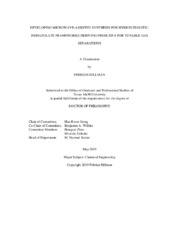| dc.description.abstract | Around half of energy consumption in the US industrial sector comes from separation process, in which are commonly achieved through distillation. One drawback for distillation is its thermally driven process requiring phase change to achieve separation, making it thermodynamically inefficient. Alternatively, membrane-based separation is a partial pressure driven process allowing energy saving up to 90 % relative to distillation. Currently, the most common membrane material is made out of polymer. However, its performance is limited by polymeric upper bound, restricting them to be commercially attractive for light gases separation.
Zeolitic-imidazolate frameworks (ZIFs) recently gained popularity for membrane-based gas separations (i.e. ZIF-8 has shown impressive propylene/propane separation). ZIFs are porous crystalline structure consist of metal center bridged by imidazolate linker. Despite their potential for gas separation applications, ZIFs crystalline nature limits their available aperture sizes. One strategy to overcome this limitation is to tune their effective apertures through the hybrid approach. By mixing different metal centers and/or linkers (M/L), the molecular sieving properties of so called hybrid ZIFs can be finely tuned, which can potentially extend the separation applications of ZIF materials for many important gas mixtures.
In this dissertation, we investigated the tunable properties of various hybrid ZIFs deriving from ZIF-8, and adopt the microwave-assisted (MW) synthesis technique, which have been shown to be advantageous over the convective heating as it provides rapid and volumetric heating. The MW synthesis significantly reduces synthesis time, produces higher yield for various hybrid ZIFs, and enable one-step synthesis of hybrid ZIFs consisting both mixed metals and linkers. MW technique also facilitate the linker doping synthesis strategy, which was previously reported to be unsuccessful through conventional approach. The linker doping strategy expands the option of imidazolate linker that can be mixed to synthesize hybrid linker ZIFs while retaining their topology. Furthermore, the first example of high quality mixed metal ZIF membranes were fabricated using MW seeding technique and secondary growth. Finally, we developed novel rapid one-pot MW synthesis of mixed linker ZIF membranes—the fastest metal organic framework membranes fabrication. Through mixing M/L, all hybrid ZIFs investigated here showed tunable molecular sieving properties and/or “gate-opening” framework flexibilities. | en |


